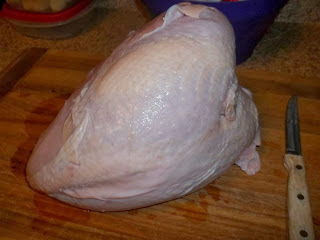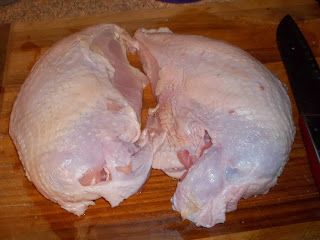 |
| Fresh Roasted Boneless Turkey Breast |
In the spirit of full disclosure, everything I learned in this post came from a Rachel Ray Special YEARS ago. The info was so helpful to me that it's become my tradition and bears repeating.
We go to my in-laws for most holidays so I don't have to cook. I REALLY enjoy left overs so it's not uncommon that I will prepare a turkey breast for home. Also, our supermarket offers a free turkey if you spend $400 during the month of October and November. Instead of getting a whole turkey (which is too much for us) I opt for a frozen turkey breast to make our holiday meal.
In this post you will learn:
1. How to bone a fresh turkey breast
2. How to roast a fresh turkey breast
3. How to make broth
Each section is clearly labeled so that you can skip to the section you need.
PART 1 - HOW TO BONE A FRESH TURKEY BREAST
First, please know that if you buy a fresh (not frozen) turkey breast you can simply ask the butcher to bone it for you. Ask to take home the bones. They make a great broth! I get a free (frozen) turkey from the supermarket each year, so I bone it myself. Plus, I like the boning process. The other option is to buy a boneless breast, but then you won't have bones to make broth.
For this project you will need:
Cutting board
Garbage bowl or small bag
Cutting Board
Plate for carved meat
Large pot to make broth and store bones
Sharp knives!
Kitchen scissors (optional)
Roasting pan
 |
| Safely thaw your turkey breast |
Safely thaw your turkey breast. [I allow mine to sit in the refrigerator for about 2 days.] Rinse the breast and pat dry with paper towels. Toss the paper towels.
 |
| Sharpen your knives! |
With a sharp knife, split your breast down the middle from top to bottom.
 |
| Split breast down the middle (front) |
Next, turn the breast over and cut down the back. It might already be cut for you! (mine was). Since you'll be cutting through bones, kitchen scissors work well for this job
 |
| Back of turkey breast |
 |
| Remove the spine |
 |
| Spine remove! |
 |
| Spine in stock pot |
 |
| Peel the meat away from the ribs |
 |
| One breast removed! |
 |
| Both breasts removed! |
PART 2 - HOW TO ROAST A BONELESS TURKEY BREAST.
For this section you will need:
Oil
Roasting Pan
Seasonings (salt, pepper, onion powder)
meat thermometer
Preheat the oven to 300 degrees. Oil a roasting pan. (I use a pizza pan). You'll need something with sides to catch the juice.
 |
| Lightly oil a roasting pan |
With the skin side down, season the bottom side of your turkey breast.
 |
| Season the bottom side of the breast |
 |
| I use basic seasonings (salt, pepper and onion powder) |
There are a million turkey seasoning mixes available! I like to keep things pretty basic, so I use salt, pepper and onion powder.
 |
| Seasoned breast bottom |
Now, turn the breast over and season UNDER the turkey skin.
 |
| Season UNDER the turkey skin |
Use a sharp knife to gently separate the skin from the meat. Season UNDER the turkey skin.
 |
| Season the top of the turkey skin |
Finally, season the top of the skin. Be generous with your seasonings!
 |
| UN-tucked turkey edge |
 |
| Tucked edges |
Now, it's ready to bake!
Bake in a 300 degree oven for approximately 45 minutes or until it reaches a temperature of 160 degrees.
 |
| Allow the meat to rest covered in foil |
Remove the turkey from the oven and cover it with foil. Since the meat will continue to cook once it's removed from the oven, leave it covered until it reaches an internal temp of 165 degrees.
Once the meat reaches 165 degrees, remove the foil. Now you're ready to eat!
 |
| Fully Cooked! |
Part 3 - HOW TO MAKE TURKEY BROTH
For this section you will need:
Turkey carcus
seasonings
large stock pot
assorted veggies (carrots, onions, etc)
If I'm cooking a full holiday meal, I keep a stock pot simmering on the stove. As I cook I'll toss in most food waste. That is to say carrot tops, onion skins, parsley stems, etc. This recipe is for a basic broth. It's SUPER easy and works well.
Place the turkey carcus, bones and trimming in a large stock pot.
 |
| Turkey carcus in a stock pot |
 |
| About this much salt |
 |
| Basic seasonings |
 |
| Add veggies to stock pot |
 |
| Simmer over med/low heat |
I store strained broth in mason jars in the refrigerator or in ziploc bags in the freezer.
Broth Pro Tip: Making from from bones is very easy and pretty forgiving. It can be cooked quickly or slowly. It can even be made in the slow cooker if you like.
If I have a long cooking day, I bone my turkey first and start the broth early. As the day goes along I add veggie scraps to the simmering pot.
If I have a short cooking day, I turn up the heat to medium and cook things a little faster. It works out great either way!


No comments:
Post a Comment